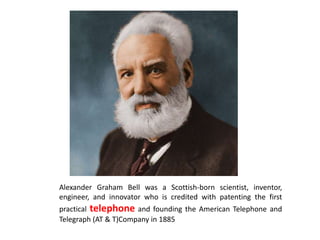P1
•Download as PPTX, PDF•
1 like•54 views
Concept of Decibels for Gain and Loss
Report
Share
Report
Share

Recommended
Recommended
More Related Content
Similar to P1
Similar to P1 (20)
MODULE 1-INTRODUCTION TO LOGARITHM AND DECIBEL.pptx

MODULE 1-INTRODUCTION TO LOGARITHM AND DECIBEL.pptx
Essential_&_Practical_Circuit_Analysis_Part 2_Op-Amps.pptx

Essential_&_Practical_Circuit_Analysis_Part 2_Op-Amps.pptx
computer-science_engineering_analog-digital-electronics_classification-of-amp...

computer-science_engineering_analog-digital-electronics_classification-of-amp...
Recently uploaded
Recently uploaded (20)
Electromagnetic relays used for power system .pptx

Electromagnetic relays used for power system .pptx
History of Indian Railways - the story of Growth & Modernization

History of Indian Railways - the story of Growth & Modernization
Call for Papers - Journal of Electrical Systems (JES), E-ISSN: 1112-5209, ind...

Call for Papers - Journal of Electrical Systems (JES), E-ISSN: 1112-5209, ind...
Convergence of Robotics and Gen AI offers excellent opportunities for Entrepr...

Convergence of Robotics and Gen AI offers excellent opportunities for Entrepr...
DFT - Discrete Fourier Transform and its Properties

DFT - Discrete Fourier Transform and its Properties
Theory of Time 2024 (Universal Theory for Everything)

Theory of Time 2024 (Universal Theory for Everything)
PE 459 LECTURE 2- natural gas basic concepts and properties

PE 459 LECTURE 2- natural gas basic concepts and properties
P1
- 1. Alexander Graham Bell was a Scottish-born scientist, inventor, engineer, and innovator who is credited with patenting the first practical telephone and founding the American Telephone and Telegraph (AT & T)Company in 1885
- 3. Learning Objectives • Understand the concept of gain and loss in electronic circuits • Learn the concept of decibels (dB) • Determine voltage gain and loss in dB
- 4. Voltage Gain of amplifier • Voltage gain of amplifier is Av: Av= ( 𝑉 𝑜𝑢𝑡 𝑉𝑖𝑛 ) Where 𝑉 𝑜𝑢𝑡 is the output voltage and 𝑉𝑖𝑛 is the input voltage • Calculate the gain of amplifier if the output voltage is 1V and input voltage is 25mV • Calculate the gain of amplifier if the output voltage is 1V and input voltage is 1mV
- 5. What are decibels dB ??? • Decibels are easy way of representing the gain (amplification) and loss (attenuation) of electronic circuits, specially amplifier. • Decibels are mainly used for measuring power level and sound levels.
- 6. Power gain in dB • Power gain in decibel is given as: Ap (dB) = 10 𝐥𝐨𝐠 𝟏𝟎 ( 𝑷 𝒐𝒖𝒕 𝑷𝒊𝒏 ) Where Pout is the output power and Pin the input power. • Calculate power gain in dB if output power is 40 W and input power is 20W. • Calculate power gain in dB if output power is 20 W and input power is 40W. • Positive value means gain and negative value means loss.
- 7. Voltage gain in decibel • Voltage gain in decibel is given as: Av (dB) = 20 log 𝟏𝟎 ( 𝑉 𝑜𝑢𝑡 𝑉𝑖𝑛 ) • Deci- (symbol d) is a decimal unit prefix in the metric system denoting a factor of one tenth. Decibel = 1 10 Bel • Bel is a unit originally designed for measuring losses of telephone cables.
- 8. Point out the differences between the scales.
- 9. Advantages of Logarithmic scale • It accommodates more number of points/data. • The scale is not linear. • Our ears responds to the sound in logarithmic way, using a decibel scale gives a more meaningful representation of audio levels. • In many stages of amplifier or antnenna, if gain is in dB (or log), it can be simply added.
- 10. Problems • Calculate the decibel gain of an amplifier if the output voltage is 100mv and input voltage is 1mV. • An amplifier provides an output voltage of 1V for an input of 1mV. Express the voltage gain of the amplifier in decibels. • Differentiated: • An amplifier provides power gain of 33dB. What output power would be produced if an input of 2mW is applied ? http://www.bcae1.com/sig2nois.htm
- 11. Decibels with reference • Often decibel are expressed as absolute power in reference with one milliwatt written as dBm. • It is useful in radio, microwave and fibre optic communication. dBm = 10 *log10 𝑃𝑜𝑢𝑡 1𝑚𝑊
- 12. Loss (Attenuation) • Av=( 𝑉 𝑜𝑢𝑡 𝑉𝑖𝑛 ) if Vout > Vin then there’s gain • If Vout < Vin, then there’s a loss. • Attenuation is defined as: Av=( 𝑽𝒊𝒏 𝑽 𝒐𝒖𝒕 ) • Therefore loss in dB can be expressed as: Av(dB) = 20 𝐥𝐨𝐠 𝟏𝟎( 𝑽𝒊𝒏 𝑽 𝒐𝒖𝒕 )
- 13. • A transmitter transmits 150w of signal through a length of co-axial transmission line. The power measured at the output end of the line is only 112 watts. What is line loss in dB ? • Determine the attenuation if the output is 1mV and input is 20mV. http://www.bcae1.com/sig2nois.htm
- 15. A typical conversation occurs at 60 dB – not loud enough to cause damage.
- 16. Plenary • Summarize at least three points you have learned from today’s session about loss and gain. • Write down one doubt that still persists in your mind. • How can you use this knowledge in your real life ???